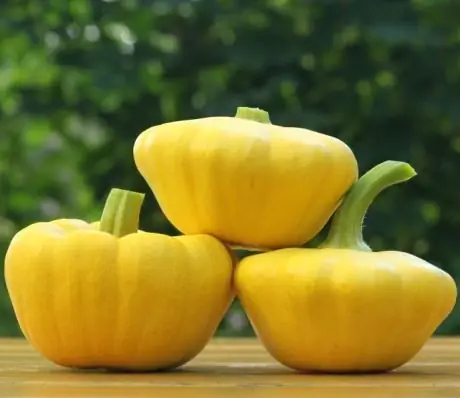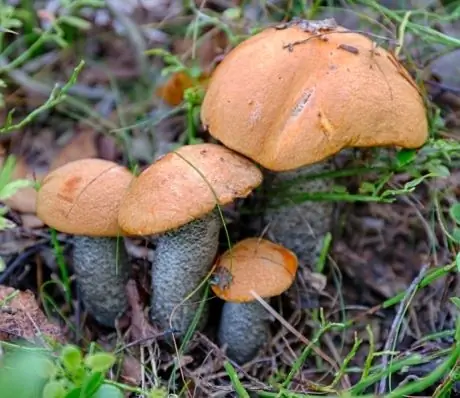- Author Rachel Wainwright [email protected].
- Public 2023-12-15 07:39.
- Last modified 2025-11-02 20:14.
Saffron
Saffron (crocus) is a perennial plant of the Iris family that grows in forests, steppes and meadows. Saffron reaches 15-20 cm in height, consists of a stem, green leaves and 2-3 flowers with three orange stigmas. Saffron blooms in autumn from October to November or in spring with flowers of white, orange, blue, purple shades. The fruits of the plant are three-celled capsules with small angular seeds. The supposed homeland of the plant is Asia Minor.
The ratio of BJU in the product

Source: depositphotos.com How to burn 310 kcal?
| Walking | 78 minutes |
| Jogging | 34 minutes |
| Swimming | 26 minutes |
| A bike | 44 minutes |
| Aerobics | 62 minutes |
| Household chores | 103 minutes |
In nature, there are about 80 types of saffron, some of them are listed in the Red Book. The most common and well-known types of saffron are:
- Alatavsky;
- Banatsky;
- Spring;
- Nigro Fight;
- Pallas;
- Remebrans;
- Geifel;
- Golden-flowered;
- Reticulate;
- Narrow-leaved.
Saffron contains flavonoids, glycosides, protocrocin, carotenoids, crocin, B vitamins, starch and essential oils (from 0.4% to 1.3%) rich in cineole and safranol.
Useful properties of saffron
The beneficial properties of saffron are due to its rich vitamin and glycosidic composition. Saffron is an effective remedy for:
- Asthma;
- Whooping cough;
- Phlegm;
- Atherosclerosis;
- Meteorism;
- Cough;
- Insomnia;
- Depression;
- Alzheimer's disease;
- Hemoptysis;
- Heartburn;
- Premenstrual syndrome;
- Premature ejaculation;
- Infertility;
- Alopecia.
The use of saffron as an aphrodisiac is also widely known.
Saffron is a good source of minerals such as copper, potassium, calcium, manganese, iron, selenium, zinc and magnesium. Potassium is an essential component of cells and body fluids that helps regulate heart rate and blood pressure.
Manganese and copper are used by the body as cofactors for the antioxidant enzyme superoxide dismutase. Iron is essential for the production of red blood cells and as a cofactor for cytochrome oxidase enzymes.
In addition, saffron is rich in many vital vitamins, including vitamin A, folic acid, riboflavin, niacin and vitamin C, which are essential for maintaining the body's immune system.
The medicinal properties of saffron have been experimentally confirmed, which are effective in:
- Anxiety disorders;
- Asthenozoospermia;
- Heart hypertrophy;
- Toxic liver damage;
- Colorectal cancer;
- Diabetic neuropathy;
- Dysmenorrhea;
- Erectile dysfunction;
- Hypertension;
- Liver cancer;
- Middle cerebral artery occlusion;
- Multiple sclerosis;
- Pancreatic cancer;
- Psoriasis;
- Respiratory system diseases;
- Healing wounds.
Saffron application
The beneficial properties of saffron were known back in the days of Ancient Egypt and Rome, where the plant was used as a dye, medicine, added to perfumery and cooking. From there, it was introduced to China and then spread throughout Europe during the Middle Ages. In Morocco, saffron was used to relieve toothaches when the first teeth were growing in children, and in France during the Renaissance, women dyed their hair with a mixture of lemon and saffron to obtain a lasting color.
Today, the largest importers of saffron in the world are Iran, India and Spain, which are recognized as producers of the highest quality spices.
Saffron is widely used in cooking and is the most expensive spice in the world. The high cost of saffron is due to the fact that the flowers of the plant contain only three stigmas, from which the spice is obtained. In order to get half a kilogram of spice, you need to process from 70,000 to 250,000 flowers, which are harvested by hand in the fall, when the flowers are fully open.
When buying saffron, you must first of all pay attention to the color of the spice. Good quality saffron should be evenly colored, bright red or dark orange in color. The spice can be purchased in powder form or with stigmas (threads).
In cooking, saffron is used to add rich color and aroma to dishes. This spice is indispensable for dishes such as risotto, bouillabaisse and paella.
Saffron is also used in cooking in soups, sauces and salad dressings.
In Indian cooking, saffron is added to milk and consumed in the diet every day to improve digestion, purify the blood and relieve fatigue and exhaustion.
In the manufacturing industry, saffron extracts are used in perfumery and also as a dye for fabrics.
In traditional medicine, saffron is a part of antidepressants, drugs that improve digestion, antiseptic and anticonvulsants.

Saffron harm
It is safe to use saffron as a medicine, provided it is taken within six weeks. Long-term use of saffron-based medications, according to reviews, may cause side effects such as dry mouth, anxiety, dizziness, drowsiness, nausea, changes in appetite, headache and allergic reactions.
The use of saffron in high doses is considered unsafe and can lead to poisoning, yellowing of the skin, eyes and mucous membranes, vomiting, diarrhea, and nosebleeds. A dose of 12-20 grams of saffron can be fatal.
Pregnant women and lactating women should not consume more saffron than is usually found in food. More saffron can lead to uterine contractions and abortion.
Caution should be used when using saffron for bipolar disorder and people with a chaff allergy.
YouTube video related to the article:
Found a mistake in the text? Select it and press Ctrl + Enter.






